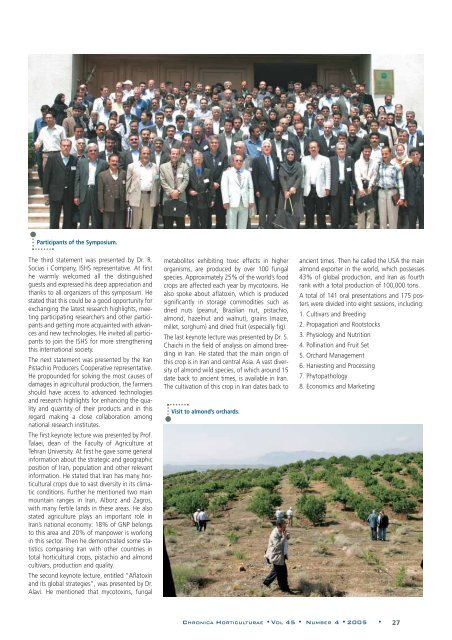The World Foliage Plant Industry - Acta Horticulturae
The World Foliage Plant Industry - Acta Horticulturae
The World Foliage Plant Industry - Acta Horticulturae
You also want an ePaper? Increase the reach of your titles
YUMPU automatically turns print PDFs into web optimized ePapers that Google loves.
Participants of the Symposium.<br />
<strong>The</strong> third statement was presented by Dr. R.<br />
Socias i Company, ISHS representative. At first<br />
he warmly welcomed all the distinguished<br />
guests and expressed his deep appreciation and<br />
thanks to all organizers of this symposium. He<br />
stated that this could be a good opportunity for<br />
exchanging the latest research highlights, meeting<br />
participating researchers and other participants<br />
and getting more acquainted with advances<br />
and new technologies. He invited all participants<br />
to join the ISHS for more strengthening<br />
this international society.<br />
<strong>The</strong> next statement was presented by the Iran<br />
Pistachio Producers Cooperative representative.<br />
He propounded for solving the most causes of<br />
damages in agricultural production, the farmers<br />
should have access to advanced technologies<br />
and research highlights for enhancing the quality<br />
and quantity of their products and in this<br />
regard making a close collaboration among<br />
national research institutes.<br />
<strong>The</strong> first keynote lecture was presented by Prof.<br />
Talaei, dean of the Faculty of Agriculture at<br />
Tehran University. At first he gave some general<br />
information about the strategic and geographic<br />
position of Iran, population and other relevant<br />
information. He stated that Iran has many horticultural<br />
crops due to vast diversity in its climatic<br />
conditions. Further he mentioned two main<br />
mountain ranges in Iran, Alborz and Zagros,<br />
with many fertile lands in these areas. He also<br />
stated agriculture plays an important role in<br />
Iran’s national economy: 18% of GNP belongs<br />
to this area and 20% of manpower is working<br />
in this sector. <strong>The</strong>n he demonstrated some statistics<br />
comparing Iran with other countries in<br />
total horticultural crops, pistachio and almond<br />
cultivars, production and quality.<br />
<strong>The</strong> second keynote lecture, entitled “Aflatoxin<br />
and its global strategies”, was presented by Dr.<br />
Alavi. He mentioned that mycotoxins, fungal<br />
metabolites exhibiting toxic effects in higher<br />
organisms, are produced by over 100 fungal<br />
species. Approximately 25% of the world’s food<br />
crops are affected each year by mycotoxins. He<br />
also spoke about aflatoxin, which is produced<br />
significantly in storage commodities such as<br />
dried nuts (peanut, Brazilian nut, pistachio,<br />
almond, hazelnut and walnut), grains (maize,<br />
millet, sorghum) and dried fruit (especially fig).<br />
<strong>The</strong> last keynote lecture was presented by Dr. S.<br />
Chaichi in the field of analysis on almond breeding<br />
in Iran. He stated that the main origin of<br />
this crop is in Iran and central Asia. A vast diversity<br />
of almond wild species, of which around 15<br />
date back to ancient times, is available in Iran.<br />
<strong>The</strong> cultivation of this crop in Iran dates back to<br />
Visit to almond’s orchards.<br />
ancient times. <strong>The</strong>n he called the USA the main<br />
almond exporter in the world, which possesses<br />
43% of global production, and Iran as fourth<br />
rank with a total production of 100,000 tons.<br />
A total of 141 oral presentations and 175 posters<br />
were divided into eight sessions, including:<br />
1. Cultivars and Breeding<br />
2. Propagation and Rootstocks<br />
3. Physiology and Nutrition<br />
4. Pollination and Fruit Set<br />
5. Orchard Management<br />
6. Harvesting and Processing<br />
7. Phytopathology<br />
8. Economics and Marketing<br />
CHRONICA HORTICULTURAE •VOL 45 • NUMBER 4 • 2005 • 27

















